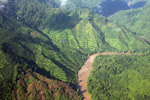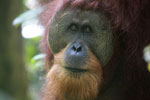A team of Malaysian and American researchers have mapped the genome of the oil palm, the oilseed that is widely used as a cooking oil and in cosmetics, cleaning products, and processed foods. The genome sequencing, which was published today in the journal Nature, identified the gene responsible for regulating the crop’s oil yield. The results could be used to boost palm oil yields, thus potentially reducing the need to clear wildlife-rich rainforests and carbon-dense peat swamps for plantations.
The gene, dubbed the “Shell gene”, controls “how the thickness of its shell correlates to fruit size and oil yield,” according to Rajinder Singh, first author of the paper and a scientist at the Malaysian Palm Oil Board (MPOB), a government agency. According to a statement from the MPOB, growers can “now use the genetic marker for the Shell gene to distinguish the three fruit forms in the nursery long before they are field-planted.” Currently it takes up to six years to determine whether an oil palm variety is high-yielding.

Fruit of the oil palm showing the thick-shelled fruit (Dura) on the left and thin-shelled fruit (Tenera) on the right. Tenera fruits yield 30 percent more oil per fruit than Dura fruits.
Credit: MPOB
Vast areas of rainforests have been destroyed in Malaysia and Indonesia over the past 30 years for oil palm plantations, turning palm oil into a top target from environmental campaigners, who have used endangered orangutans as a symbol for the risk of converting natural forests into palm estates. Scientists have warned that the crop represents “single most immediate threat to the greatest number of species”. Therefore the news that palm oil yields could get a boost from improved genetic stock could potentially reduce the need to expand plantations in sensitive areas.

Conversion of rainforest for oil palm in Malaysia in 2012. Oil palm far outperforms other traditional oilseeds like rapeseed (canola) and soy in terms of oil yield. But while large producers are able to produce high yields — and profit margins — small holders, who account for the millions of hectares of plantations in Indonesia, Malaysia, and Africa, see much lower yields. Boosting their productivity on existing plantations could generate huge environmental and economic dividends.
However a positive conservation outcome is not a forgone conclusion. Research on cattle ranching in Latin America has shown that in some cases increasing agricultural productivity — and therefore profitability — simply incentivizes further conversion by landowners. Nevertheless, most conservationists view boosting yields as a critical step to protecting forests in a world where demand for food and fuel is surging as the middle class swells. Getting more oil out of less land, means more areas can be left wild.
“The discovery that regulation of the Shell gene will enable breeders to boost palm oil yields by nearly one-third is excellent news for the rainforest and its champions worldwide,” said the MPOB’s Choo Yuen May.
“The discovery of Shell indicates a clear path toward more intensive use of already planted lands, and thus should lessen pressures to expand the land area devoted to oil palm, notably onto endangered rainforest land — a major concern for the environment and a rallying point for activists in recent years,” added co-author Robert Martienssen, co-founder of Orion Genomics and a plant geneticist at Cold Spring Harbor Laboratory.

Oil palm plantation in Malaysia. The researchers analyzed the genome of two commercially grown oil palm species: the African oil palm (Elaeis guineensis) and South American oil palm (Elaeis oleifera). They were able to determine that the two species diverged when the Old and New World split.
CITATION: Rajinder Singh et al (2013). Oil palm genome sequence reveals divergence of interfertile species in Old and New worlds. NATURE July 25, 2013 doi:10.1038/nature12309
Related articles
Greening the world with palm oil?

(01/26/2011) The commercial shows a typical office setting. A worker sits drearily at a desk, shredding papers and watching minutes tick by on the clock. When his break comes, he takes out a Nestle KitKat bar. As he tears into the package, the viewer, but not the office worker, notices something is amiss—what should be chocolate has been replaced by the dark hairy finger of an orangutan. With the jarring crunch of teeth breaking through bone, the worker bites into the “bar.” Drops of blood fall on the keyboard and run down his face. His officemates stare, horrified. The advertisement cuts to a solitary tree standing amid a deforested landscape. A chainsaw whines. The message: Palm oil—an ingredient in many Nestle products—is killing orangutans by destroying their habitat, the rainforests of Borneo and Sumatra.
Palm oil both a leading threat to orangutans and a key source of jobs in Sumatra

(09/24/2009) Of the world’s two species of orangutan, a great ape that shares 96 percent of man’s genetic makeup, the Sumatran orangutan is considerably more endangered than its cousin in Borneo. Today there are believed to be fewer than 7,000 Sumatran orangutans in the wild, a consequence of the wildlife trade, hunting, and accelerating destruction of their native forest habitat by loggers, small-scale farmers, and agribusiness. Gunung Leuser National Park in North Sumatra is one of the last strongholds for the species, serving as a refuge among paper pulp concessions and rubber and oil palm plantations. While orangutans are relatively well protected in areas around tourist centers, they are affected by poorly regulated interactions with tourists, which have increased the risk of disease and resulted in high mortality rates among infants near tourist centers like Bukit Lawang. Further, orangutans that range outside the park or live in remote areas or on its margins face conflicts with developers, including loggers, who may or may not know about the existence of the park, and plantation workers, who may kill any orangutans they encounter in the fields. Working to improve the fate of orangutans that find their way into plantations and unprotected community areas is the Orangutan Information Center (OIC), a local NGO that collaborates with the Sumatran Orangutan Society (SOS).